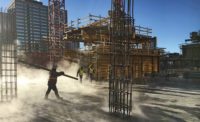If you’ve had a kid in an area school, chances are you’ve seen the work of Adolfson & Peterson. Since its founding in 1946, the Minneapolis-based, family-owned firm has worked on 1,500 K-12 schools and 62 college campuses. It’s a source of pride within the company, which has constructed dozens of educational facilities in Colorado and Wyoming.

President Rick Whitney cites A&P’s award-winning 2013 renovation of the historic Mapleton School in Boulder as one of his favorite K-12 projects in the state.
Likewise, if you’ve been to the doctor lately, you may have walked into an A& P building. The company has completed multiple projects for University of Colorado Health and, two years ago, finished the $86.4-million, 275,376-sq-ft Kaiser Permanente Lone Tree Medical Offices.
Minimizing noise, dust and disruption is vital during renovations to occupied, active buildings, such as schools and hospitals. A&P gets high marks from David Diener, senior project manager of facilities design and construction for UC Health, for running projects as cleanly and inconspicuously as possible.
“They’re very customer-service-focused,” says Diener, who also oversaw A&P’s work for Kaiser Permanente. “They understand health care. They understand, particularly, the strenuous requirements when you’re working in an occupied facility in terms of all the ICRA [that is, infection control risk assessment] requirements to contain the dust, to contain the noise and to be very respectful of the operations of the health facility that are going on [during] construction.”
For the company’s part, Doug Johnson, A&P vice president of preconstruction, says the keys are consideration and planning. “You’ve got to really have the mentality that you’re a guest in their house,” Johnson says. “You have a job to do, and you need to come in and get it done for them. But they don’t have to put up with dust and noise and smells and that general construction stuff if you’re preplanning and doing it right and executing the plan.”
Schools, meanwhile, present a particular challenge. As A&P Senior Vice President Tom Horsting puts it, “The kids are coming on August 1, no matter what.”
“If you wait until the day school’s out to mobilize and get started, it’s difficult to get done,” adds Chief Operating Officer Kent Weicht. “So what we end up doing is working with the school district to put the structural steel in for the HVAC units, for example. Get in and do it on weekends—get as much as you can done early so that when you go into the shutdown of the school, you’ve already got things prepped, you’ve already got materials supplied. … The name of the game is to get in early. It’s the preplanning piece and the scheduling and coordination.”
That may sound basic, but, as Weicht and Horsting both observe, school districts have called A&P more than once to assist other contractors or even finish projects for them. For Johnson, meanwhile, it’s the completed school building—and the excitement of the students—that gets his blood pumping.
“There’s nothing better than [seeing] a kindergartener or a first-grader walking into a brand-new, shiny building and their mouth just dropping open. They get excited about being in school, and the building just comes to life with the kids in it. That is a really neat feeling,” Johnson says.
He believes A&P’s sense of purpose in constructing buildings for the public good gives it an advantage in the job market.
“Everyone is competing for employees. And [you need to] supply your employees with something that’s a little bit more—and it’s not about money. It’s about what you get to build. If you look at the product types that Adolfson & Peterson builds, we build hospitals, we build K-12 schools, we build higher education, we build libraries, police stations, fire stations, community centers, recreation centers. It’s all community-based stuff that’s very important for those communities, and we build those facilities in the communities where our employees work.


Post a comment to this article
Report Abusive Comment